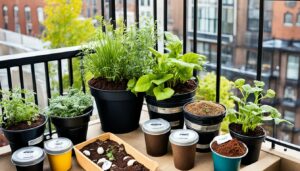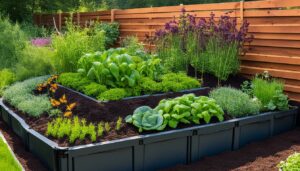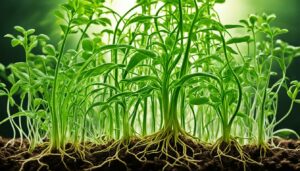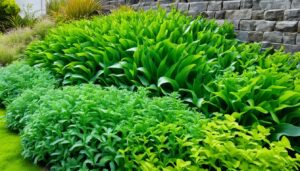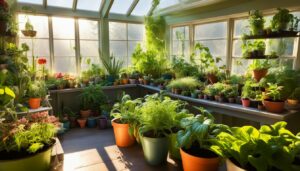Did you know that a single native oak tree can host over 500 species of caterpillars, whereas non-native tree species might support fewer than a dozen? This striking fact underlines the profound impact native plants have in sustaining local wildlife. As the backbone of sustainable gardening for wildlife, native plants form essential relationships within our ecosystems, making a native plants local wildlife garden not only a beautiful sanctuary for humans but a critical haven for our feathered and fluttering neighbours.
In a world that’s rapidly urbanizing, creating a space that focuses on attracting wildlife with native plants has never been more valuable. With a mindful approach to wildlife garden design, we can transform our gardens into thriving ecosystems that bolster biodiversity and provide indispensable resources for local wildlife. Indeed, fostering a plot of native growth is not just a hobby; it’s a conservation effort that contributes significantly to the environmental tapestry of our planet.
Key Takeaways
- Understanding the importance of native plants in supporting diverse ecosystems and attracting local wildlife.
- Recognizing the key role of native plants in sustainable gardening practices that conserve water and nurture the soil.
- Learning how to create a wildlife garden design that is both aesthetically pleasing and environmentally responsible.
- Discovering the benefits of using native species to cultivate a self-sustaining habitat that flourishes year-round.
- Gaining insights into how planting native flora contributes to ecosystem health and the well-being of local fauna.
- Planning a successful native plants local wildlife garden by selecting right species and appropriate gardening techniques.
Benefits of Incorporating Native Plants in Your Garden
Creating a garden that not only beautifies your outdoor space but also contributes to the environment is a rewarding endeavor. Utilizing native plants offers a myriad of benefits, spanning from aesthetic appeal to eco-sustainability. Let’s delve into how these indigenous species can be pivotal in shaping a vibrant and self-sustaining oasis that champions biodiversity and bolsters local wildlife habitats.
Saving Time and Resources with Self-Sustaining Landscapes
When you integrate native plants into your landscape, you embark on a journey of creating a low-maintenance paradise that syncs perfectly with the natural cycles of your local environment. These plants are perennial powerhouses, adapted to the regional climate and naturally equipped to thrive without the need for constant care. They are champions at conserving water and warding off weeds, making them a cost-effective and time-saving choice for gardeners who desire to create an efficient and self-sustaining habitat.
Attracting Diverse Wildlife and Promoting Biodiversity
Landscaping for native wildlife goes beyond the visuals; it’s about curating a living, breathing space that resonates with the local fauna. Biodiversity with native plants transforms your garden into a sanctuary for various creatures, from the iridescent flutter of butterflies to the harmonious songs of birds. With each species blooming at different times, your garden becomes a year-round haven that entices and nurtures the intricate web of life that depends on these indigenous botanicals.
Supporting Local Ecosystems and Conservation Efforts
More than just beautifying your private landscape, opting for native plants radiates positive reverberations throughout the environment. You are contributing to vital conservation efforts by providing indispensable habitats for declining populations of native insects like caterpillars, pivotal for the sustenance of local bird life. Whether starting small or enriching an existing space, the gradual introduction of these native varieties can significantly influence the conservation of resources, protection of wildlife, and overall ecological balance.
- Embrace local plant species for a self-sustaining landscape
- Create a wildlife-friendly garden to enhance biodiversity
- Conserve water and support local wildlife habitats through thoughtful plant selection
With every native plant you tuck into the soil, you solidify your role as a steward of the land, promoting the health and longevity of the local ecosystem. The act of creating a wildlife-friendly garden is a step towards a greener, more sustainable future, enveloping your home in the natural splendor that once freely roamed these lands.
Native Plants Local Wildlife Garden
Building a native plants local wildlife garden starts with the careful selection of species that thrive in your specific region, creating an oasis for both flora and fauna. These plantings not only embellish your garden space but also encourage a symbiotic relationship with the surrounding wildlife, embodying the essence of sustainable landscaping. Let’s delve into how to plant native species for wildlife and ensure a successful native plants local wildlife garden.

Selecting the Right Native Plants for Your Area
Selecting the right native species is the cornerstone of planting a successful native wildlife garden. It involves understanding the specifics of your local ecosystem—such as climate, soil types, and indigenous wildlife. Native species are adept at handling local climatic variations and soil conditions, making them perfect candidates for your garden ecosystem. This planning stage is critical for creating a harmonious natural space that will be low-maintenance and self-sustaining over time.
Design Principles for a Wildlife-Friendly Garden
A well-designed wildlife-friendly garden goes beyond merely choosing the right plants; it encompasses the organization of these plants in a way that mimics natural ecosystems. By emphasizing native varieties, you seamlessly blend beauty with functionality, creating a landscape that is attractive to both humans and wildlife. Consider incorporating elements like layered plant heights, water features, and undefined garden edges to create a true sanctuary for local biodiversity.
Landscaping Techniques to Maximize Habitat Value
When applying landscaping techniques, the goal should be to maximize the habitat value for local wildlife. This can be achieved through various methods such as planting native shrubs and trees to provide shelter, including host plants for native butterflies and moths, and installing bee-friendly blooms that offer abundant nectar sources. A landscape structured with these elements in mind becomes a thriving habitat for myriad wildlife.
Dealing with Common Challenges Like Pests and Climate
Leveraging the intrinsic resilience of native plants allows gardeners to face less trouble from common garden pests and climate-induced stress. These plants coevolved with local wildlife and are naturally equipped to resist many of the challenges that non-native species struggle with. However, it’s always beneficial to be prepared and aware of potential issues that could arise, ensuring that your wildlife garden remains a healthy and thriving ecosystem year-round.
Conclusion
Embarking on the journey of starting a local wildlife garden is not only a step towards embellishing your outdoor space but also a profound act towards environmental stewardship. The adoption of native plants local wildlife garden philosophies enriches our communities with verdant diversity and strengthens the symbiotic ties between nature and suburban life. As gardeners weave the vibrant tapestry of Native Plants 101, they cultivate a legacy both aesthetically captivating and ecologically significant. The resources at hand, such as PlantTAGG’s technology, serve as navigational tools in this green endeavor, making the selection and care of native species more accessible than ever.
The significance of native plants extends far beyond the ornamental; they are pillars that support a flourishing ecosystem. Through their roots, stems, and leaves, they invite a choir of local fauna, from pollinators to birds, to partake in the bounty of a garden thoughtfully attuned to the environment’s natural rhythm. The insight that gardeners gain transforms their verdant labors into a beacon of sustainability, one that influences neighbors and communities to turn their attention to the vital role native plantings play in conserving our ecological heritage.
In summary, whether your hands are seasoned with soil or you’re just planting your first seedling, the endeavors within native plants local wildlife garden initiatives are commendable. These efforts foster not only a refuge for wildlife but a haven for human connection to the earth. As we continue to grow in knowledge and dedication, we join an evergreen movement—a collective effort to ensure that the beauty we admire today will flourish for generations to come, one backyard at a time.



